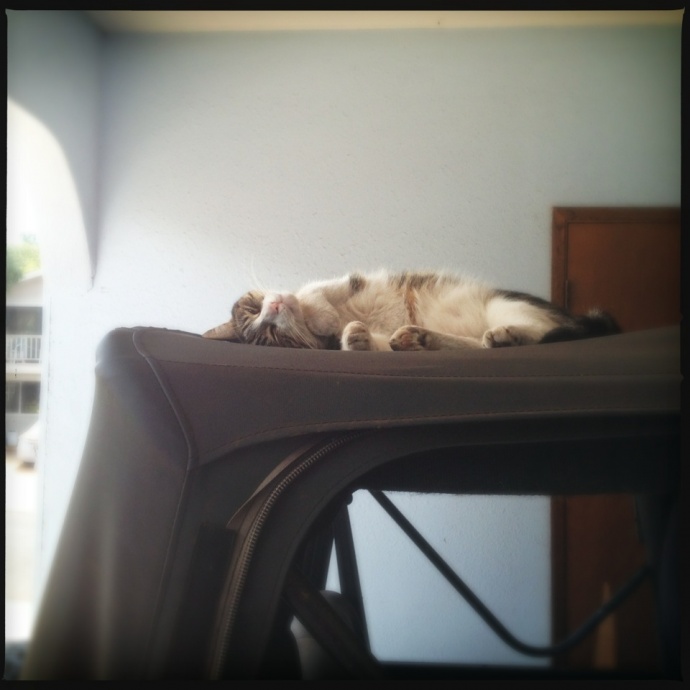Feral Cats Weigh in on “Feral Cat Problem”
WARNING: SATIRE… MOSTLY.
Most of this is utter nonsense, but some of it near the end is actually founded in fact.
By Vanessa Wolf
A public forum focusing on issues surrounding feral cats and chickens on Maui is planned for tomorrow night.
With respect to the issues at hand, Mayor Arakawa recently stated, “feral chickens and cats have become a significant problem in our community, and both residents and visitors are impacted by the effects of these feral populations; However, each feral group presents unique challenges and it is imperative that well-researched control methods are employed in a strategic and humane manner. It is my hope that this discussion will lead to workable solutions.”
Feral Cat Syndrome – or “free-roaming” as they prefer to call themselves – is a serious issue.
“Scraps” (not his real name), a 1-year-old feral cat living in Maui Meadows, spoke to us confidentially about what life is really like on the plumeria-lined streets.
“Look, none of us chooses to free-roam. Life just… happens. Some of are born into the system, others get booted into it,” he explained.
“I happen to come from a long line of free-roamers. I was raised by a pretty typical kitten. None of us ever knew our dad, let alone what color he was.”
Scraps then gestured toward a small black and white cat on the edge of the lawn, “My girlfriend Mittens, on the other hand, was put out after the family that adopted her as a kitten decided to move to the mainland.”
Scraps then shrugged and looked away forlornly, asking for a minute to collect his thoughts.
The dangers feral cats face are almost endless: malnutrition, psychological disorders, FIV infection and other catfight transmitted diseases, unwanted pregnancies, catnip abuse, trash can robbery, and sexual and physical assault have all been found in high proportions among these felines.
One study found the rates of major depression, conduct disorder and post-traumatic stress were 33 times more likely among feral or “free roaming” felines as compared with their house-based peers.
When questioned about these statistics, Scraps expressed unbridled hostility toward such “kept” pets and their owners.
“Sure, they have cozy beds and all the ‘nip they can snort, but the way I see it, I have opted out of ‘the system.’ I’m choosing to live off the grid and away from the interference of the government agencies and bureaucracies that complicate everyday life. I won’t be controlled by the man.”
When gently asked if he ever grows tired of the grind and considers attempting life as a family pet, Scraps became notably agitated.
“Humans? They’re terrifying. I can’t get within 10 feet of one without… hisssss! HISSSSSS!”
Suddenly realizing he was speaking confidentially with a human being, Scraps tore off into some nearby bushes and could not be found again for further comment.

This cat was too fat to be feral, but it still did some bad things to this Jeep upon which it slumbers. Maui Now staff photo.
In short, life on the streets is a struggle for survival for most feral cats.
Many recent castoffs new to outdoor living start by panhandling for change or a bowl of milk from misinformed children who don’t realize dairy is bad for felines.
Eventually most newly feral cats most likely turn to illegal means to survive; many will become involved in prostitution, drugs, stealing, squatting in and even peeing in people’s innocent open-top Jeep Wranglers in order to “mark” them as their territory.
Free-roaming cats can be found in big cities, small towns, rural areas and suburban neighborhoods around the globe. Some are former pets that were lost or abandoned and there are the rare few who have chosen the lifestyle and prefer to “live on the edge.”
Feral cats often live in a group of related cats called a colony which typically occupies and defends a specific territory where food and shelter are available. If one colony is eradicated, another tends to take its place.
ASPCA-funded research indicates that it costs between $100 and $125 to pick up, house and then euthanize a feral cat whereas sterilizing the same animal costs only $35 to $55 at a typical low-cost clinic.
Regardless of the outcome, should you see “Scraps” in your neighborhood, we recommend that you do not attempt to lure him inside with balls of yarn or promises of Whisker Lickin’s. Word on the street is he annihilated a Lay-Z-Boy recliner in less than four hours and is not afraid to do it again.
Have an idea for a fun, funny or thought-provoking story or topic? Get in touch: we want to hear from you. – Vanessa (@mauinow.com)











